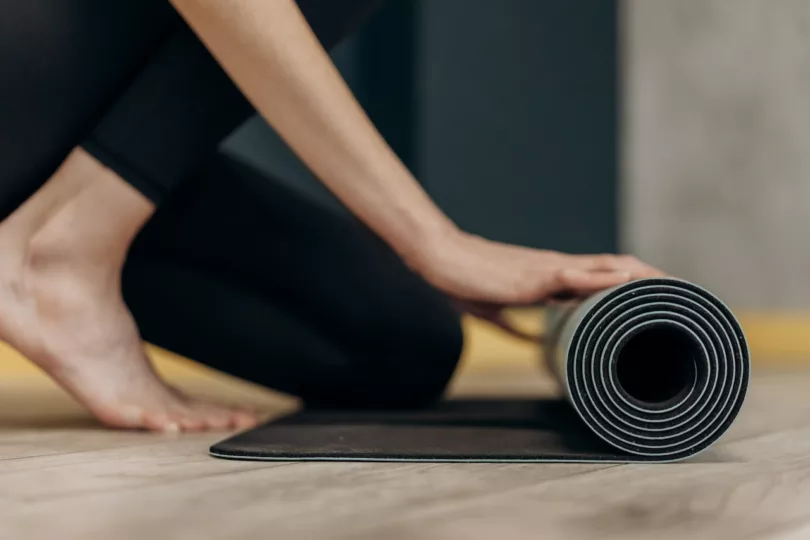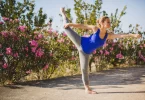Welcome to the world of yoga poses for core strength, where the fusion of ancient practice and modern fitness comes alive. The importance of a strong core cannot be overstated, as it forms the foundation for overall physical well-being. Yoga poses for core strength specifically target and engages the muscles of the core, fostering stability and balance. Throughout this journey, we will explore a diverse array of yoga poses for core strength that will challenge and strengthen your abdominal, back, and pelvic muscles. Whether you are a seasoned yogi or a beginner, the practice of yoga poses for core strength will empower you to cultivate a deeper mind-body connection, leading you toward a more robust and resilient body. Let’s dive into the transformative world of yoga poses for core strength and unlock the potential within you.
Table of Contents
Mountain Pose (Tadasana)
Mountain Pose is a fundamental yoga posture that sets the stage for a strong foundation and core engagement. To practice Mountain Pose, stand with your feet hip-width apart, ensuring equal weight distribution on all four corners of your feet. As you ground down, draw your navel inwards and lengthen your spine, creating a sense of stability and alignment. This pose not only enhances posture but also cultivates core strength and stability. By incorporating Mountain Pose into your yoga practice, you establish a solid foundation and lay the groundwork for further exploration of core-strengthening poses.
Here are some of the benefits of Mountain Pose:
- Improves posture
2. Strengthens the core
3. Improves balance
4. Increases flexibility
5. Promotes relaxation
6. Reduces stress
Here are some tips for practicing Mountain Pose:
- Keep your core engaged throughout the pose.
2. Don’t lock your knees.
3. Lengthen your spine up through the crown of your head.
4. Relax your shoulders.
5. Gaze forward and breathe deeply.
Plank Pose (Kumbhakasana)
- Plank Pose (Kumbhakasana) is one of the most popular yoga poses for core strength and overall body stability. To perform this pose, begin in a push-up position with your arms straight, wrists aligned under the shoulders, and legs extended behind you. Engage your core muscles by drawing your navel toward your spine and keeping your body in a straight line from head to heels. Hold this position for as long as you can, breathing deeply and maintaining the engagement of your core. Plank Pose is a powerful exercise for strengthening the abdominal muscles, back, and shoulders. Regular practice of Kumbhakasana can help improve core stability, enhance posture, and build endurance. It also activates other muscle groups, contributing to a full-body workout. Incorporating Plank Pose into your yoga routine is an excellent way to challenge and develop your core strength, leading to a more robust and balanced body.
Here are some of the benefits of plank pose:
- Builds strength in your core
2. Improves your posture
3. Increases your balance
4. Reduces back pain
5. Improves your flexibility
Boat Pose (Navasana)
- The Boat Pose (Navasana) is a powerful yoga asana that targets the core muscles, providing an excellent workout for building core strength. To perform this pose, sit on the mat with your legs extended and back straight. As you inhale, lift your feet off the ground, keeping your legs together. Simultaneously, raise your arms in line with your shoulders. The balance required in this pose engages the abdominal muscles, making it one of the most effective yoga poses for core strength. Hold the position for a few breaths, gradually increasing the duration as you build more strength. Regular practice of Boat Pose can help tone the core muscles, improve balance, and develop better posture. Incorporating yoga poses for core strength into your practice can lead to a stronger and more stable core, enhancing overall physical performance and body awareness.
Side Plank Pose (Vasisthasana)
The Side Plank Pose (Vasisthasana) is a challenging yet rewarding yoga asana that engages the core muscles, providing an excellent workout for building core strength. To perform this pose, begin in a plank position with your wrists directly under your shoulders. Shift your weight onto one hand and rotate your body to the side, stacking your feet on top of each other. Raise your free arm towards the ceiling, forming a straight line from head to heels. The Side Plank Pose is highly effective for targeting the obliques, abdominals, and lower back muscles, making it one of the most beneficial yoga poses for core strength. Regular practice of this pose can help stabilize the core, improve balance, and develop a strong sense of body awareness. Incorporating yoga poses for core strength into your practice can lead to a stronger and more resilient core, supporting overall physical performance and posture.
Warrior III Pose (Virabhadrasana III)
Warrior III Pose (Virabhadrasana III) is a powerful yoga asana that targets multiple muscle groups, making it an excellent addition to a routine focused on yoga poses for core strength. To perform this pose, start in the Mountain Pose (Tadasana), then shift your weight onto one leg while lifting the other leg backward. At the same time, hinge your torso forward until it’s parallel to the ground, creating a “T” shape with your body. Engage your core muscles to stabilize and maintain balance. The Warrior III Pose demands significant core engagement to keep the body aligned and steady. This pose not only strengthens the core but also works on the back, glutes, hamstrings, and shoulders. As you hold the pose, you’ll feel your abdominal muscles working to keep your body steady. Regular practice of Virabhadrasana III can improve core stability, balance, and concentration, providing a holistic approach to enhancing overall body strength and flexibility.
- Here are some tips for practicing Warrior III pose:
Keep your core engaged throughout the pose.
- Don’t let your back round.
Breathe deeply.
- If you start to feel pain, rest for a few seconds and then try again.
Dolphin Plank Pose (Makara Adho Mukha Svanasana)
- The Dolphin Plank Pose (Makara Adho Mukha Svanasana) is a variation of the traditional plank pose that further challenges and strengthens the core muscles. To perform this pose, start in a forearm plank position with your elbows directly under your shoulders. Engage your core and lift your hips, forming a straight line from head to heels. The Dolphin Plank Pose is excellent for targeting the deep abdominal muscles, including the transverse abdominis, which play a crucial role in maintaining core stability. This pose also engages the shoulders, arms, and legs, creating a full-body workout. Incorporating Dolphin Plank Pose into your yoga routine can enhance overall core strength, stability, and balance. Regular practice of yoga poses for core strength can lead to improved posture, reduced risk of injuries, and better performance in other physical activities. Add this powerful pose to your practice to experience the transformative benefits it offers for your core muscles.
Bow Pose (Dhanurasana)
Bow Pose is a backbend pose in yoga that is known for its many benefits. It is a challenging pose, but it is also very rewarding.
To do Bow Pose, start in a prone position with your feet hip-width apart and your toes pointing behind you. Bend your knees and grab your ankles with your hands. Pull your feet towards your buttock, keeping your arms straight. Lift your head and chest off the ground, arching your back.
In this pose, your body should form a bow shape. Your core should be engaged and your back should be straight. Hold the pose for 5-10 breaths, then slowly release.
Here are some of the benefits of Bow Pose:
- Improves flexibility in the back, shoulders, and hips
- Strengthens the core
- Opens the lungs and chest
- Improves circulation
- Reduces stress
Bow Pose is a great pose to add to your yoga practice. It is a challenging pose, but it is also very rewarding. So next time you are feeling flexible and strong, try Bow Pose. You may be surprised at how much you enjoy it.
Locust Pose (Salabhasana)
- The Locust Pose (Salabhasana) is a dynamic yoga pose that targets the muscles in the lower back and the entire core region. To practice this pose, lie on your belly with your arms by your sides, palms facing down. Inhale and lift your chest, head, arms, and legs off the mat simultaneously. Keep your gaze forward and engage your core muscles to support your lifted position. The Locust Pose is an excellent addition to any yoga routine focusing on core strength. It activates the muscles along the spine, lower back, and glutes, helping to build a strong and stable core. Regular practice of yoga poses for core strength like Salabhasana can improve posture, increase flexibility, and alleviate lower back pain. Incorporating Locust Pose into your practice can enhance the strength and endurance of your core muscles, leading to better overall stability and support for the body during various physical activities.
Bridge Pose (Setu Bandhasana)
- The Bridge Pose (Setu Bandhasana) is a yoga pose that offers numerous benefits, especially for core strength. To practice this pose, lie on your back with your knees bent and feet flat on the mat, hip-width apart. As you inhale, press your feet into the mat, lift your hips, and bring your chest toward your chin, creating a bridge-like shape with your body. Engage your core muscles to support the lifted position and hold for a few breaths. Bridge Pose is an effective addition to any routine focusing on yoga poses for core strength. It targets the abdominal muscles, lower back, and glutes, helping to strengthen and tone the core region. Regular practice of Setu Bandhasana can improve core stability, alleviate back pain, and enhance posture. Incorporating Bridge Pose into your yoga practice can lead to a stronger, more balanced core, providing greater support for the spine and enhancing overall body alignment and functionality.
Upward Plank Pose (Purvottanasana)
Upward Plank Pose is a challenging yoga pose that strengthens the core, stretches the front of the body, and opens the chest. It is a great pose to improve balance and flexibility.
To do Upward Plank Pose, start in a tabletop position with your hands shoulder-width apart and your knees hip-width apart. Press your hands into the floor and straighten your legs, lifting your hips towards the ceiling. Keep your core engaged and your spine long. Hold the pose for 5-10 breaths, then slowly lower back down to the tabletop position.
Here are some tips for practicing Upward Plank Pose:
- If you are new to Upward Plank Pose, you may want to start by holding the pose for a shorter amount of time. As you become stronger, you can gradually increase the amount of time you hold the pose.
- If you have any wrist pain, you may want to use blocks under your hands.
- If you start to feel pain in your lower back, release the pose and rest.
- Breathe deeply throughout the pose.
- If you are feeling dizzy or lightheaded, release the pose and rest.
Conclusion
In conclusion, incorporating yoga poses for core strength into your fitness routine can yield remarkable results. These targeted exercises effectively engage and strengthen the core muscles, promoting better stability and balance. The practice of yoga poses for core strength not only enhances physical performance but also fosters a deeper mind-body connection. By dedicating time to these poses, you can build a strong foundation for overall fitness and well-being. So, embrace the power of yoga poses for core strength and embark on a transformative journey towards a healthier and more resilient you. Start reaping the benefits of a robust core with the practice of yoga poses for core strength today.
Read Also Mental benefits of yoga health: Yoga for Mindfulness







